– Edited to add:
During to a flood that hit my house, the fabrics and partially completed parts of this costume were destroyed.
So until I decide to actually redo everything with new fabrics, the pages for this gown only serve as a documentation and memory of what I made; not as a dress diary. Navigation for this page:
Portraits, photographs and description of the gown
The different bodices – Bodice with jewel decorations – bodice with pearl decorations – dark red velvet bodice
The different skirts – Duchesse silk skirt with court train and lace decorations – Striped taffeta skirt – Plain satin or duchesse skirt
Planning of my gown – Cost and time estimations
The portraits and photographs of the gown
The following pictures seem to depict the same woman wearing the same gown – at least at first sight:
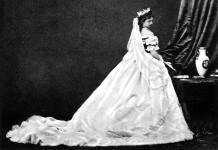 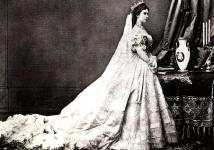 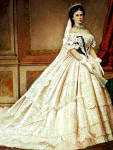
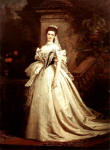 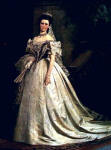 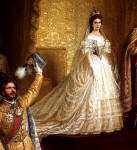
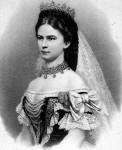 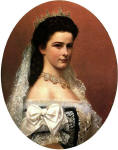  
(Pictures 1&2 seem to show the same scene, photographed just seconds apart; but on close inspection the decorations in the background – drape, table on the right, tablecloth, even the likely seeming vase – are totally different.
The third picture is a portrait that seems to have been painted from the photographs in pictures 2 & 7.
Pictures 4 & 5 depict the same portrait, but in different exposures and resolutions.)
A description of the gown says:
„She’s wearing a gown of white silk brocade, elaborately decorated with flower motives of silver thread; a velvet bodice with real pearl lacings, white puffed sleeves of lace and black, diamond set bodice; around the neck, Hungarian diamond jewelry. Her coronation cloak is made of blue velvet, lined with white duchesse silk.
The gown is a creation of the fashion designer Charles Frederic Worth.“
I have to object to this description, of which I’m not even remotely certain that it was made by a contemporary observer who was present at the coronation. My reasons:
– The gown may be made from lots of different materials, but in my opinion none of them is brocade. The skirt is – in most paintings and the photographs – made of a non-patterned, shiny material; probably silk duchesse. I also can’t find anything „brocade“ on the bodice.
– I have searched and searched, but could find nothing silver on the gown (except the jewelry settings). The ‚flowers‘ are in the lace with which the gown is decorated, but by no means embroidered; and apparently, they’re not silver either.
– The pearls are anything decorative, but definitely not „lacings“.
– The puffed sleeves are white in just one of the portraits / photographs – in all other pictures, they have the same color as the bodice. They’re decorated with white lace, though.
– The bodice seems dark in most pictures, but in two of them, it’s midnight blue; and I have no clue where that observer might see any „diamond settings“. It is possible that this description means the jewel decorations along the pearl strings, though.
– The coronation cloak that’s mentioned in the description appears in none of the portraits.
A propos portraits. As mentioned before, the above shown pictures *seem* to depict the same gown, but there are differences – not only in the photographs and portraits, as described above, but also in the gowns.
The different bodices
There seem to be two bodices in the above shown pictures, of which one is decorated in two different ways.
The bodice with the jewel decorations
The bodice with the jewel decorations is visible on most of the pictures. It’s decorated at the front with rows of pearls and drop-shaped blue sapphires, surrounded by diamonds.
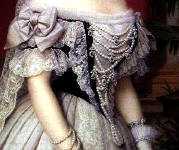 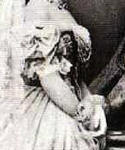 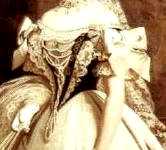 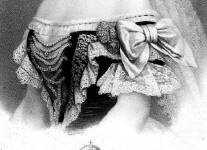 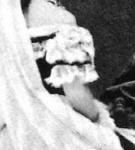 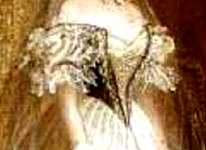 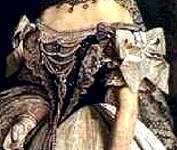
This bodice seems to be made of midnight blue (sometimes also just plain black) silk velvet and is decorated with Victorian flower laces.
Those laces are flat sewn over the velvet (at the V-shaped front) and then extend into ruffles along the edges of the V-front and the sleeves in all pictures except of the first, where the lace around the „V“-shaped insert at the front is directly sewn into a ruffle without the flat appearance. The front has a V-shaped insert, which seems to be made of ivory silk satin or duchesse.
The sleeves are decorated with silk taffeta or duchesse bows, which seem to be larger in the paintings but smaller in the photographs. Only the sixth picture shows the sleeves in white.
The neckline is decorated with what seems to be narrow sheer pleated ruffles of a sheer material in most of the painted portraits and pleated ruffles of the silk satin, taffeta or duchesse in the photographs (the black and white pictures).
I can by no means say what the white, V-shaped insert in the front of the bodice is made of.
In some pictures it looks like ‚just‘ plain duchesse; in others, like pleated duchesse and in *again* others, like layered tiny ruchings made of a sheer material.
Then there’s the bodice with the pearl decorations.
It’s made of the same materials and decorated the same way as the aforementioned blue jeweled bodice, just that the jewels were replaced with drop-shaped pearls, indicating that it might be the same bodice just with different decorations (or the artists who painted the portraits took some kind of artistic freedom).
Also, the first picture again shows the sleeve puffs in white instead of blue, and the second picture clearly shows a blue bodice.
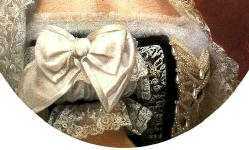 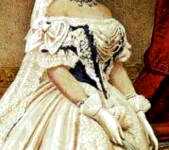
And then, there’s the red bodice – dark red velvet.
It looks a bit like the other bodices; however, the lace decorations are different at close inspection and it’s also a *lot* more off the shoulder than the other bodice.
Plus, this bodice has no pearl or jewel decorations at the front. The bows on the sleeves are also slightly different from the above mentioned other bodice(s).
It’s worn, however, with the same, pearl decorated gloves, veil, crown and necklace as the other bodices.
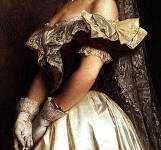
The different skirts
There are at least three different skirts to be seen in the portraits.
First, the duchesse silk skirt with the court train and the lace decorations.
In all pictures, it is worn with a lace apron.
As this skirt appears in original photographs as well as in the painting of the coronation, it’s almost safe to say that this skirt was actually worn at the coronation. It’s also the most ornate of all three skirts.
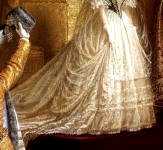 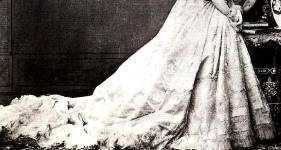 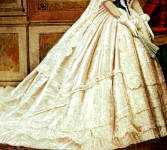 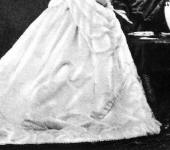 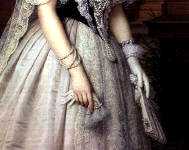
The skirt seems to be made of ivory silk taffeta or duchesse, of which I would guess the latter as this was obviously one of Worth’s favorite materials which he used on several of his gowns.
The skirt front is cut on the straight grain; the pattern running in a circle over the material.
The hem of the skirt is decorated with pleated frills of the skirt material, which seem in some of the images to be covered with another layer of pleated frills of a sheer material. This frill is about 5 inches wide.
The lace and sewn-in pleats decorations vary in the pictures. None of the paintings show the skirt decorations in the way in which they appear in the photographs.
Just to study the placement of the lace close-up in the paintings / photograph in which they are really recognizable (warning – *giant* picture!)
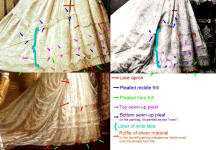
As you can see from that study, the laces were never painted the same way in portraits and photograph.
Then there’s the „striped taffeta“ skirt.
Again, with a court train, but a slightly different shape than the first skirt with the lace decorations. The stripes in the taffeta have, in my opinion, been too well observed as this could just be a „simple“, painter’s version of the lace decorated skirt.
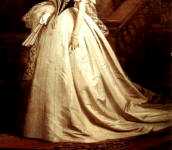 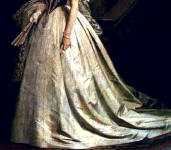
The red bodice is worn with a plain, satin or duchesse skirt.
This one doesn’t seem to have a court train. The overall shape is also different. It’s interesting that the painter painted two seams into the skirt.
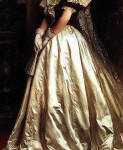
Now.. to the planning of my gown.
I want…:
– the skirt from the photograph:

but without the court train, and most definitely without that lace apron. I think I can also live very happily without the veil. For budget reasons, I think I’ll also go for just one layer of lace and omit the additional sheer ruffle over the pleated hem frill.
– The bodice from this portrait:

in midnight blue velvet, but with the rather plain frills along the neckline of this photograph:

Plus, I like the idea of the description of „silver flower embroideries“, so I will replace the flat lace part with, well, just that: embroidered, silver flowers.
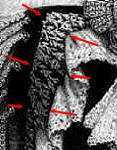
I’ll also go for slightly pleated silk duchesse for the white V-shaped insert.
No planning on the jewelry yet; for budget reasons I think I’ll first go just for pearl string decorations. If I should accidentally stumble over a nice, affordable necklace with drop-shaped jewels that I can unpick for the jewel decorations, I’ll do that… but if not, I’ll wait until the time comes when such a necklace crosses my path accidentally.
Now… to the cost and time estimations, which I write here before starting anything. The „finished gown“ page will have another calculation, based on the actual time and expenses I had for this gown.
If you would like to omit those calculations as they are rather boring – this way to the skirt making.
Materials I’ll need for this gown:
Remember that the below shown costs are *just* the plain material costs – so if you would have someone make you such a gown, you’d have to pay their work as well.
Considering that I estimate this gown to take about 100 hours of work, and considering that a *good* costume maker should earn at least $15 per hour (remember, she must pay taxes from that, *plus* make a living somehow!), *plus* adding some funds for research, shipping of materials and the finished gown, notions etc. – about $150 or so….
This means the price for a gown like this should have at least $1650 *added* to the below listed, plain material costs, if you would want a professional costume maker to make you this gown.)
| Status |
Item |
My expenses |
Regular costs
(see explanation below) |
 |
Material for skirt / bodice – silk duchesse – 9 meters
bought last year at a sale for incredible EUR 6 / $8 per meter |
~ $ 72 |
~$ 810 |
 |
Silk velvet for the bodice
(I’m using scraps from a former sewing project) |
~ $ 0 |
~$ 30
(with dyes) |
 |
Linen to line the bodice
(from old bed linens) |
~ $ 0 |
~$ 15 |
 |
Vintage lace for decorations
bought a long time ago at an auction |
~ $ 60 |
? ~$ 150 |
 |
Boning and grommets for bodice |
~ $15 |
~ $15 |
 |
Lining for skirt (7 yards of silk satin) |
— |
~$ 140 |
 |
Silver bullion for embroidery |
~ $ 10 |
~ $ 10 |
| …so just the material will (did) cost: |
~$ 157 |
~$ 1170 |
| …if you’d have this gown made, add the above explained ‚costume maker‘ costs of… |
~$ 1650 |
~$ 1650 |
| …and get to a total price of… |
~$ 1807 |
~$ 2820 |
Explanation of „regular costs“:
For this particular gown I have to add this:I was *incredibly* lucky to find the silk duchesse at that sale, to be able to buy the lace at that price at an auction two years ago and to have the scraps of midnight blue silk velvet left which I can now use.
If I would have had to buy those things regularly in a store, the prices for those items would have looked different – as in „I couldn’t have afforded to buy them“ – as listed in the second prices column above.
And, believe me, a sale at which duchesse silk is sold at $8 per meter is *so* rare that in fact, I have just seen one in my whole life – and that was the sale where I bought the fabric.
Back then, as described below, I didn’t write lists, like I did above, when estimating a gown’s price – which, as I can clearly see now, was a mistake.The interesting thing is that a bit more than two years ago, when someone asked me to have this gown made by me, I gave a ballpark figure of $2,000 – $2,500 at max, depending on material quantity (which I couldn’t estimate yet, as I had not made any patterns yet) and price of that material.
To be honest, I would have charged that customer no more than about $2,000 in the end, because back then I liked her a lot, thought she was nice and some kind of ‚friend‘ – hell, I helped her building a website and message board, talked long to her on the phone several times, gave her dealer contacts when she asked for them etc. – and we always got along nice, that’s at least what I thought…
My aimed charge for her was more than $800 less than the above estimation of the „regular“ material pricing and labor costs *AND* would also have included the jewelry (crown, necklace, jewel decorations on bodice!), lace apron and veil, which I have omitted in this estimation, as I either don’t want them or have not planned them yet… but they would have taken even more material and work than listed above – I’d say, at least $500 more – so my estimation would have left me with about $300 that I would have earned to make this gown…
Eventually she said that she couldn’t afford the gown as she had to pay some taxes and was also not satisfied with her weight – well, that can happen; I wasn’t too disappointed. Especially because she suggested that perhaps at a later point of time, I could still make the gown for her.
But last year she said to me on a different occasion: „I’m a businesswoman, you’re an artist. There are worlds between us.“
And that’s basically how this ‚friendship‘ that obviously never existed ended when she broke all bridges because ‚some of her customers didn’t like me, and she didn’t want to lose customers‚.
Ouch! That hurt immensely. From the ‚business‘ aspect, that decision might have been correct from her point of view – but from the *human* aspect, it was absolutely wrong. Would you kick someone’s ass who helped you a lot just for business reasons? If you’d do, please leave my site…
Well, I have by now learned better than to make „prices for friends“, and also learned to write up a studying page and cost estimation tables before I give ballpark figures on *anything*.You might ask yourself why I have listed no lining for the skirt in my estimation.
The truth is that I’m currently totally short of lining material and short of money to buy some. This is why I have decided to leave the skirt without lining, but rather make a petticoat, which I can later wear with other gowns, too. I could also line the skirt at a later point of time – the fact that it will consist of basically a half circle and two rectangles makes this easy.Explanation:
 : already have that material : already have that material
 : ordered that material : ordered that material
 : don’t have the material (yet) : don’t have the material (yet)
Costs are calculated by the material price; no shipping/handling fees for those materials are included here.
The above listed ‚costume maker‘ calculation was made just to satisfy one of my biggest needs:
To show people that *good* costume makers are often underpaid or undervalue their work (or the amount of work that goes into a gown).
I’ve experienced that myself when I was still a professional costume maker and *still* heard often that my prices are ‚too high’… just because people don’t take into consideration (or are simply not aware) how much time, work, craftsmanship and research go into making such gowns. I myself often miscalculated the costs for a customer’s gown, in the sense of me thinking that I wouldn’t need so much material / so much time, ending up with doing very much for considerably little.
So – the calculation is for ‚those‘ people as well as for myself, so that I might know what exactly my spare time, in which I make these costumes, is worth (I wish I had made those very exact breakdowns when I was still professional – would have spared & gained me much at the same time)  |
So… after clarifying what I want… Let’s go on to the skirt making. |
Navigation for this part of the page:
[catlist categorypage=yes]
|






























One Response to “Elisabeth of Bavaria”